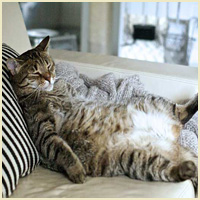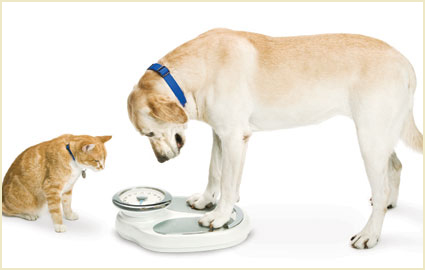Cat Weight Loss – Dog Weight Loss
 As a veterinarian, cat – dog weight loss is important, and I spend a lot of time talking about weight control to my owners. I think there is no doubt that an animal (no matter the species) on the slender side, is happier, healthier, and more active than one on the hefty side. But are they really happier and healthier?
As a veterinarian, cat – dog weight loss is important, and I spend a lot of time talking about weight control to my owners. I think there is no doubt that an animal (no matter the species) on the slender side, is happier, healthier, and more active than one on the hefty side. But are they really happier and healthier?
Does it matter if a Sheltie weighs forty pounds instead of thirty? If a trail horse is ninety pounds overweight? “Dr. Bercier, you’re fat shaming my dog!” Not at all. There are body condition score charts for animals loosely related to the human body mass index. These charts have to do with the amount of weight that should be carried on a given skeletal size – it is presented as outlines of body shape to make it easier to identify where your animal falls. An example: One German Shepherd might be 65cm at the withers with larger bone and strong muscling, and another might stand 55cm with smaller, lighter bones, and less muscling. Ninety-five pounds will look very different on each. If you look at these charts and are not sure if your pet is overweight, ask your veterinarian for advice. Many of us are staunch proponents of weight loss and will be more than happy to talk about it!
 So… are significantly overweight (obese) animals really unhealthy just because of their weight? I think they are. Adipose tissue does not simply sit there quietly as a storehouse for excess energy in the form of fat. It is an active tissue that secretes hormones, inflammatory proteins, and chemical and molecular messengers. In the past few years, researchers have identified over 100 substances produced by adipose tissue. These substances create an extensive communication network within the adipose stores and between it and other organs. Some are directly related to other diseases as well.
So… are significantly overweight (obese) animals really unhealthy just because of their weight? I think they are. Adipose tissue does not simply sit there quietly as a storehouse for excess energy in the form of fat. It is an active tissue that secretes hormones, inflammatory proteins, and chemical and molecular messengers. In the past few years, researchers have identified over 100 substances produced by adipose tissue. These substances create an extensive communication network within the adipose stores and between it and other organs. Some are directly related to other diseases as well.
As an example of how powerful these small proteins can be: One in particular, called leptin, promotes inflammation and oxidation, among other things. Inflammation includes all the ways the body strives to protect itself and remove abnormalities and invaders. These include changes in blood vessels, specific cellular recruitment, destructive molecules and chemicals… The result of inflammation is more inflammation until the cause is gone – always until the cause is gone. Oxidation is essentially degeneration and aging at the cellular level. That’s overly simplified, but I’m sure no one wants a chemistry discussion here. (If you do, call me, it’s fascinating stuff!) Be sure to eat those antioxidant fruits and veggies to improve your own body! If the body continues to add adipose tissue, the amount of leptin released increases further. Before long, the signal that the body is satisfied, from a hunger standpoint, is deactivated by this protein. This results in more calories consumed, more adipose tissue accumulated, and more leptin made and released.
Owners with obese animals feel sorry for them because “they are always hungry” so they give treats, potentiating the problem. They are hungry because of this nasty little leptin protein. More leptin promotes more inflammation, cellular aging is accelerated, and obesity-linked disorders begin to arise. Many obese dogs are diabetic or have heart disease. Many obese horses are laminitic or have insulin resistance. Obese cats have more urinary tract diseases, and problems in the mouth. The good news is that as the body condition score decreases and weight is lost, the amount of leptin (and other such proteins) also decreases, and these diseases can begin to resolve if not too extreme.
 Some of the other proteins produced by adipose tissue directly cause inflammation, and in doing so, signal the release of other molecules which serve the same purpose. Since inflammation continues until the cause is gone, and adipose tissue constantly recruits inflammatory mediators, you can appreciate that obesity itself is a constant source of mild inflammation. Again though, if that forty pound Sheltie drops a few pounds, the amount of these proteins in the blood will decrease accordingly. When the dog/horse/cat approaches normal standards for its body weight, all of this abnormal chemistry is resolved. Happier, healthier animal!
Some of the other proteins produced by adipose tissue directly cause inflammation, and in doing so, signal the release of other molecules which serve the same purpose. Since inflammation continues until the cause is gone, and adipose tissue constantly recruits inflammatory mediators, you can appreciate that obesity itself is a constant source of mild inflammation. Again though, if that forty pound Sheltie drops a few pounds, the amount of these proteins in the blood will decrease accordingly. When the dog/horse/cat approaches normal standards for its body weight, all of this abnormal chemistry is resolved. Happier, healthier animal!
Another interesting recruitment by fatty tissue is for a certain white blood cell (the macrophage) which causes it’s own set of problems. Adipose tissue does not contain a lot of blood vessels. As the tissue grows, it will outgrow its blood supply and begin to die. The job of the macrophage is to remove this tissue, but as they are signaled to begin their work, they will recruit others, as well as send out their own chemical messengers which tend to cause inflammation (of course!). The result of the macrophage’s work is the production of molecules that cause oxidation, as a byproduct of their work – rather like a PacMan, eating away damaged tissue. Again though, all of these adipose specific proteins decrease as the animal loses weight. Happier, healthier animal.
If your animal is having weight issues, please address it sooner rather than later. It can seem like a daunting task, but it is not that difficult to get weight under control with proper nutrition and appropriate exercise. We can help you get started and keep you on the right path for success. Weight management is so very important at any age, but especially for older pets. At K9Strong, we have more weight-loss patients than we do rehabilitation ones at present, and we are as excited as the owners to see each pound come away!

Recent Comments